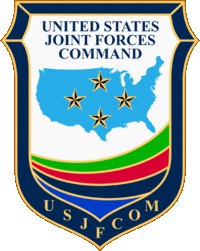- United States Joint Forces Command
-
United States Joint Forces Command 
Emblem of the United States Joint Forces CommandActive 1999–2011 Country United States Type Unified Combatant Command Size At its height, 1.16 million active and reserve soldiers, sailors, airmen and marines Headquarters Norfolk, Virginia Nickname USJFCOM Commanders Combatant Commander Disestablished United States Joint Forces Command (USJFCOM) was a former Unified Combatant Command of the United States Armed Forces. USJFCOM was a functional command that provided specific services to the military. The last commander was Army Gen. Raymond T. Odierno. As directed by the President to identify opportunities to cut costs and rebalance priorities, Defense Secretary Robert Gates recommended that USJFCOM be disestablished and its essential functions reassigned to other unified combatant commands. Formal disestablishment occurred on August 4, 2011.
Contents
History
USJFCOM was formed in 1999 when the old United States Atlantic Command was renamed and given a new mission: leading the transformation of the U.S. military through experimentation and education. USLANTCOM had been active from 1947 to 1993 as a primarily U.S. Navy command, focused upon the wartime defence of the Atlantic sea lanes against Soviet attack. After the end of the Cold War, a 1993 reorganization gave the Command a new acronym, USACOM, and brought United States Army Forces Command and Air Combat Command under its authority.[1]
In late 2004, U.S. Joint Forces Command assumed the role of primary conventional force provider. This landmark change assigned nearly all U.S. conventional forces to Joint Forces Command. Requirements, for example, for U.S. service personnel to support the transformation of the Armed Forces of Liberia, were fed to JFCOM, in this case via Africa Command, and JFCOM liasied with the service staffs to obtain available forces. Along with this responsibility came the task to develop a new 'risk-assessment' process that provided national leaders a world-wide perspective on force-sourcing solutions.
Its operations and exercises included Noble Resolve, an experimentation campaign plan to enhance homeland defense and improve military support to civil authorities in advance of and following natural and man-made disasters[2] and Empire Challenge, an annual intelligence, surveillance and reconnaissance (ISR) interoperability demonstration.[3]
Mission
United States Joint Forces Command was the only combatant command focused on the transformation of U.S. military capabilities. The commander of USJFCOM oversaw the command's four primary roles in transformation – joint concept development and experimentation, joint training, joint interoperability and integration, and the primary conventional force provider as outlined in the Unified Command Plan approved by the President. Its Unified Command Plan designated USJFCOM as the "transformation laboratory" of the United States military to enhance the combatant commanders' capabilities to implement the president's strategy. USJFCOM developed joint operational concepts, tested those concepts through rigorous experimentation, educated joint leaders, trained joint task force commanders and staffs, and recommended joint solutions to the Army, Navy, Air Force and Marines to better integrate their warfighting capabilities.
Organization
USJFCOM included members from each branch of the U.S. military, civil servants, contract employees, and consultants. It had four component commands, a sub-unified command (Special Operations component is SOCJFCOM and eight subordinate activities, including: Joint Warfighting Center; Joint Systems Integration Center; Joint Transformation Command for Intelligence; and Joint Warfare Analysis Center (JWAC). JFCOM's Service components were the CONUS based commands that provided forces to other combatant commands: United States Army Forces Command (FORSCOM), United States Fleet Forces Command (USFLTFORCOM), Air Combat Command (ACC), and United States Marine Corps Forces Command (MARFORCOM).
Disestablishment
On 9 August 2010 Secretary of Defense Robert Gates announced that Joint Forces Command has been slated for elimination as a budget-saving measure.[4][5] General Ray Odierno was given the task of winding down JFCOM.[6] On 6 January 2011, the plan was officially approved in a memorandum by President Obama.[7] On 4 August 2011, Joint Forces Command cased its flag colors[8] and officially disestablished on 31 August 2011.
Former commanders
- Admiral Harold Gehman, USN (1999–2000)
- General William F. Kernan, USA (2000–2002)
- Admiral Edmund P. Giambastiani, USN (2002–2005)
- General Lance L. Smith, USAF (2005–2007)
- General James N. Mattis, USMC (2007–2010)
- Lieutenant-General Keith M. Huber, USA (2010) (acting)
- General Raymond T. Odierno, USA (2010–2011)
See also
References
- ^ Find Article: U.S. Atlantic Command, Now USACOM, Assumes New Role US Navy Press Releases
- ^ USJFCOM information on Noble Resolve
- ^ Empire Challenge 09
- ^ Find Article: Officials: Belt-tightening will cut major command Associated Press report
- ^ Tilghman, Andrew (9 August 2010). "Gates to kill JFCOM, cut general officer billets". Marine Corps Times. http://www.marinecorpstimes.com/news/2010/08/military_gates_cuts_080910w/. Retrieved 10 August 2010.
- ^ Find Article: Gates to shut down USJFCOM in 2011 US Defense Secretary Press Release
- ^ Obama, Barack (6 January 2011). "Presidential Memorandum – Disestablishment of United States Joint Forces Command". White House Press Office. http://www.whitehouse.gov/the-press-office/2011/01/06/presidential-memorandum-disestablishment-united-states-joint-forces-comm. Retrieved 7 January 2011.
- ^ Garamone, Jim (4 August 2011). "Joint Forces Command Cases Its Colors". American Forces Press Service via Defense.gov. http://www.defense.gov/news/newsarticle.aspx?id=64927. Retrieved 4 August 2011.
External links
- USJFCOM official site
- Small Wars Journal stitch-together of news articles covering JFCOM deactivation
Regional responsibilities Functional responsibilities Inactivated Atlantic Command - Joint Forces Command - Space Command - Strike CommandCategories:- Commands of the United States armed forces
- Military units and formations in Virginia
- Military units and formations established in 1999
- Military units and formations disestablished in 2011
Wikimedia Foundation. 2010.
